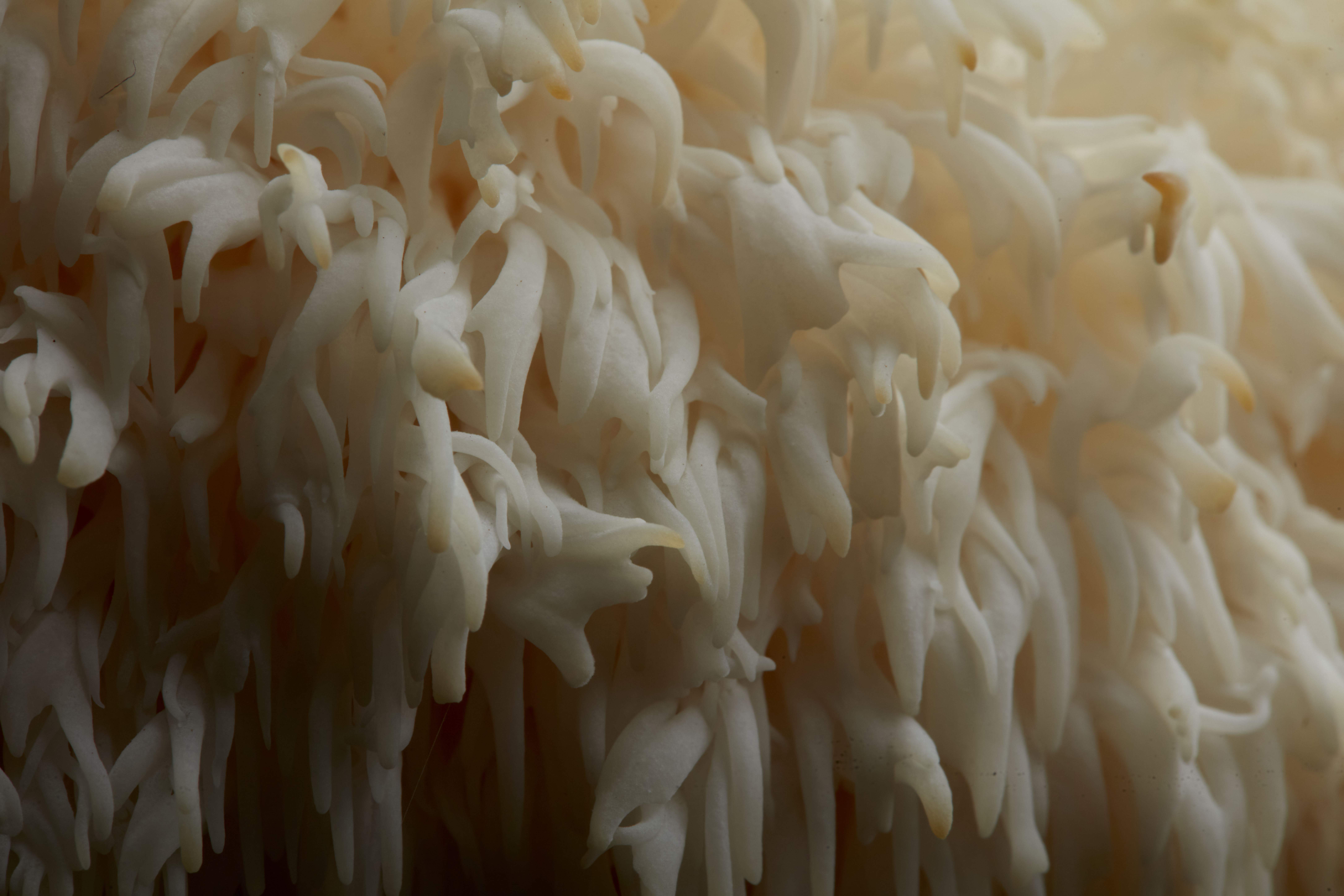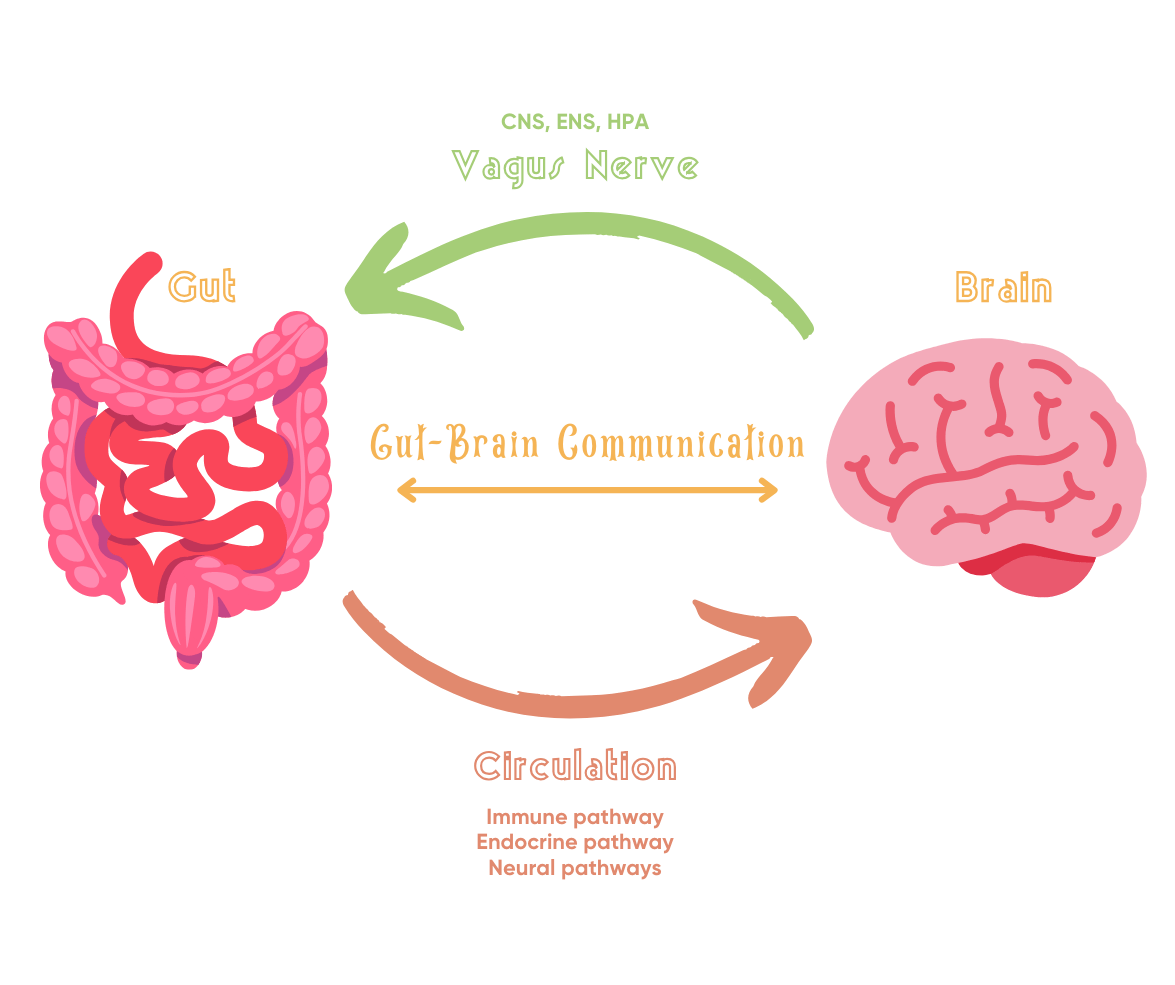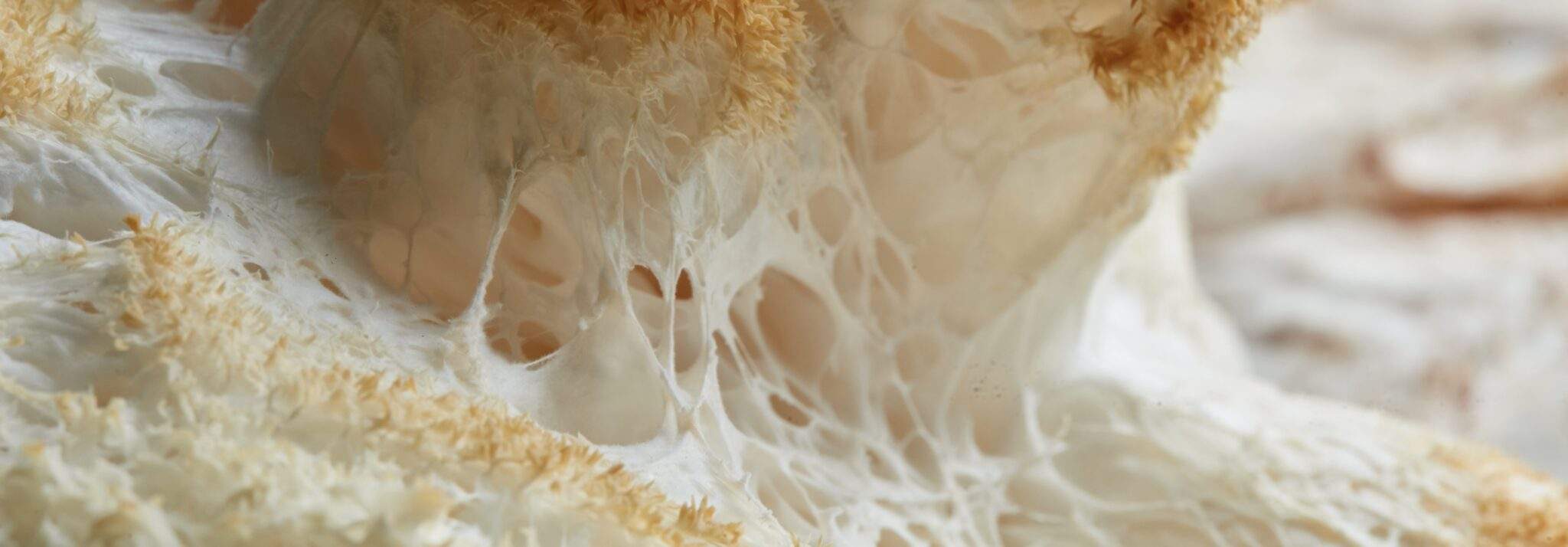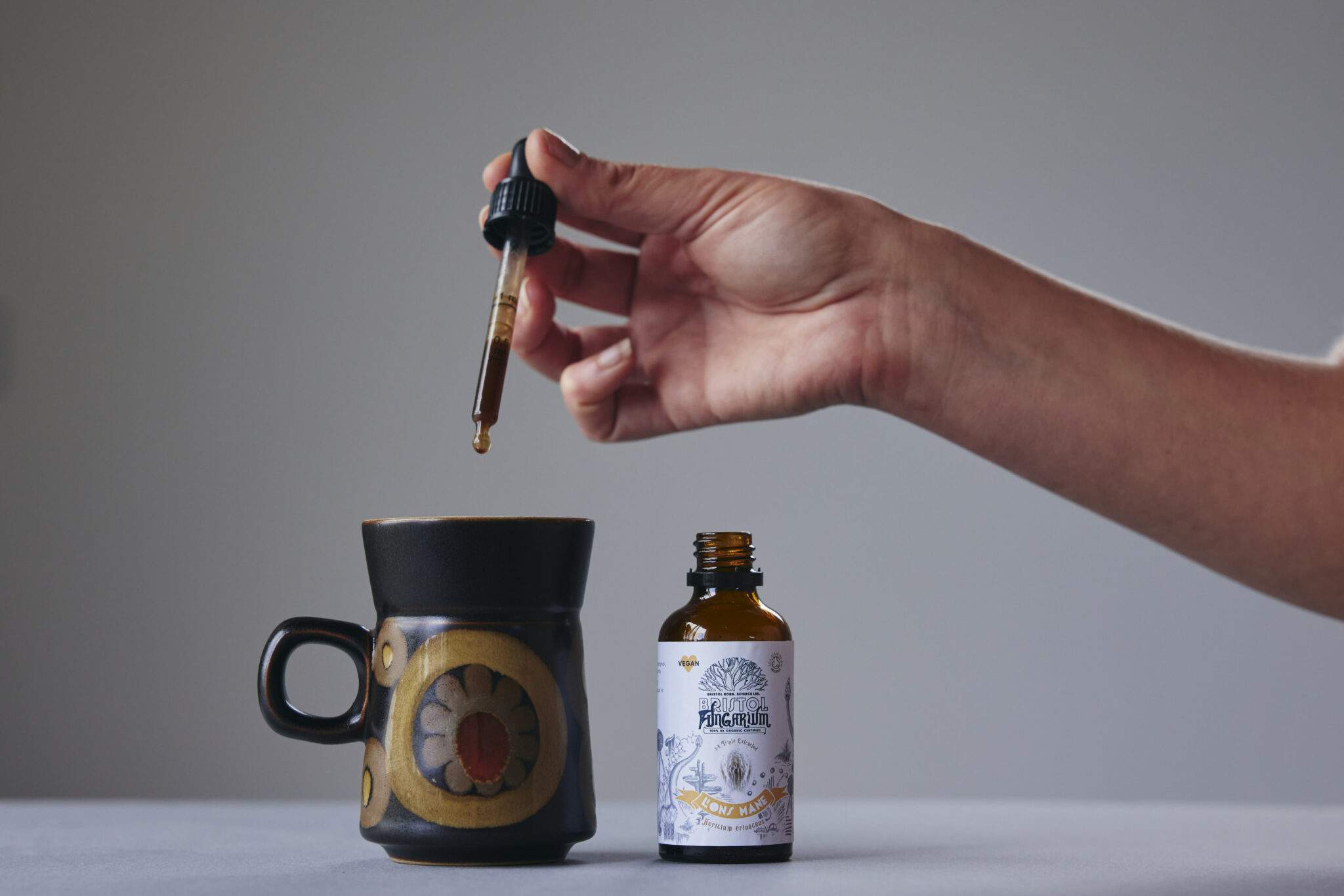Unlocking the Enchanting Benefits & Powers of Chaga Mushrooms
12 January 2023Medicinal Mushrooms: Exceptional Boosters of Immune Function
16 January 2024Lion's Mane & The Gut-Brain Axis
A deep dive into Hericium erinaceus and its specific effects on the ‘gut-brain axis’ – the direct link between our gut’s digestion & absorption processes, and our cognitive functions.

Lion’s mane. We’re becoming ever more familiar with this ancient super-shroom. Talk of the town, mushroom heavyweight, a real show-stopper. This shamanic-looking big white beard of a fungi has gained immense attention for its potential to support mental clarity and focus in recent years, making it popular for anyone seeking ways to get the best out of their brain (which, in our productivity-obsessed society, is a helluva lot of us).
From herbalists to mycologists, students to biohackers, ADHD warriors and yogis to nutritionists and therapists alike, lion’s mane’s cognition enhancing potential has likely made its way into your vocabulary in some way or another. But did you know lion’s mane has potentially groundbreaking implications for our gut microbiome as well? Long before lion’s mane was neatly labelled by our Western culture as a nootropic – it was used to “nourish the gut, fortify the spleen” and heal gastrointestinal tract issues.
Here at Bristol Fungarium we sometimes refer to Lion’s mane as ‘the cosmic grandad’ – a powerful fungi to which we owe much of our heritage, and that we grow more of on our little Somerset mushroom farm than anyone else in the UK.
To discover more about lion’s mane’s impressive potential to support us both body and mind, for this article we’ve joined forces with Claire of Learn Botanics for a deep dive into Hericium erinaceus and its specific effects on the ‘gut-brain axis’ – the direct link between our gut’s digestion & absorption processes, and our cognitive functions.
So, without further ado – let’s jump into the research:
Nourishment for the nerves
Lion’s mane or Hericium erinaceus AKA Bearded Tooth Fungus, Hóu tóu gū “monkey head mushroom” in Chinese, and yamabushitake “mountain monk mushroom” in Japanese, traditionally grows on dead or old broadleaf trees and is used historically as both food and medicine. In traditional Asian medicine practices, Lion’s mane is said to be nutritive to the five internal organs: liver, lung, spleen, heart, and kidney (1).
In contemporary practice however, Lion’s Mane is most noted for its neuroprotective potential; a powerful tonic for our nervous system showing value in a wide range of neurological and digestive conditions. As such, this rich myconutrient fungus is sometimes referred to as “Nature’s Nutrient for the Neurons”.
So what are lion’s mane’s influences on the gut-brain neural pathway connection? The clinical evidence on gut health is increasingly connected to mental health… So, how lion’s mane plays a part in supporting the nervous system is an interesting topic indeed.
The growing gut-brain conversation
Also known as the ‘Gut Brain Axis’ – the Gut Brain Connection is an evolving area of neuroscience that is increasingly discovering how our central nervous system (CNS) and the human gastrointestinal (GI) tract communicate. This encompasseses the brain and spinal cord, our (CNS) and how neural pathways signal directly to the gut (our enteric nervous system or (ENS) and vice versa. Thus, this is a two way communication pathway and plays a huge role in our nervous, endocrine, and immune systems (2).
The vagus nerve establishes one of the main connections between the brain and the gastrointestinal tract and sends information about the state of the inner organs to the brain via afferent neurosignalling. This crucial cranial nerve can play a huge part in the release of neurotransmitter mediators such as serotonin, dopamine and glucagon-like peptide-1m (a hormone produced in the gut involved with metabolic functions such as insulin secretion and management of food intake) and how corresponding receptors expressed on vagal afferent neurons. Through automatic responses, the gut then modulates a range of digestive functions including gut motility (how the food moves through the GI tract), absorption of nutrients, inflammatory responses to stress, and mucosal levels in the gut (3). In short, if there is imbalance in these neurotransmitters, it can affect both mental health and gut function.
“Dysbiotic gut microbiota via specific neural pathways can limit secretion, motility, and blood flow within the GI tract and, additionally, transfer neural signals via the vagus nerve and spinal cord routes (2)”.
According to a meta-analysis human study, with 59 controlled case studies, the gut microbiome of adults diagnosed with cognitive conditions including major depressive disorder, bipolar, psychosis and schizophrenia, anxiety disorders, eating disorders, autism, OCD, ADHD, and PTSD have significant microbiota patterns. This offers the potential to develop target gut biome biomarkers, carving the way for new phytotherapy research such as medicinal mushrooms to support mental health (4).

Natural nootropics
There is an ever-increasing body of research that supports the notion that oxidative stress-driven neuroinflammation is a fundamental cause in neurodegenerative diseases such as dementia, MS and Parkinson’s disease. In recent clinical studies Lion’s mane has been identified to have significant therapeutic value in degenerative cognitive conditions (5) with recent studies showing that lion’s mane is not only safe, but has important potential as a neuroprotective and neurotrophic therapeutic agent in neurological conditions (6).
Under the tutelage of the Neuroscience Dept. at UWE, we are working with a PHD student in their final year who will be specifically investigating our native lion’s mane, exploring its potential to support research into the Neuroprotective Effects of Edible Mushroom Extracts as a Novel Treatment for Neurodegenerative Conditions. Initially as in-vitro studies, with hopes to get into the realms of human clinical trials over the coming years.
This research will shine a local light on years of global studies. One RCT human study of participants between 50 and 80 years with mild dementia, took 3000 mg of Lion’s Mane powder per day for 16 weeks showed improved cognitive function on the Revised Hasegawa Dementia Scale (which measures comprehension, memory, concentration etc) compared to placebo (7).
Another recent 2019 double blind, placebo controlled comparative study, showed significantly improved cognitive function and prevented deterioration, based on the Mini Mental State Examination (MMSE), a neurological assessment widely used for the dementia diagnosis, compared to placebo (8).

Cognitive reinforcements
In a 2020 double-blind, parallel-group, placebo-controlled study involving 30 patients with MCI, a 16-week treatment with 3000 mg of LM extract resulted in increased scores on the cognitive function scale in the experimental group compared to the placebo group (9).
In a 2020 randomised study, involving patients with mild Alzheimer’s Disease, with an extract of 350 mg/capsule, showed improved scores on the activities of daily living (e.g., personal hygiene, dressing, preparing food, etc.) over 49 weeks. These studies suggest that may be Lion’s mane is a well-tolerated and safe herb for the management of Alzheimer’s Disease (9).
One of the key research areas of Lion’s Mane and its potential for cerebral function, is how it can stimulate the synthesis of Nerve Growth Factor (NGF) in nerve cells. This is a specific protein that plays a critical role in many areas of homeostasis in the body but is particularly important in the development and maintenance of nerve cells, including neurons. Two polysaccharide-rich compounds of Lion’s Mane have been identified as being active in stimulating NGF production, these are hericenones and erinacines (13).
A 2013 study showed the effect of Lion’s Mane extract when mixed with NGF on the growth of developing nerve cells. The research sought to explore the neuroprotective action of this extract on nerve cells exposed to oxidative stress, and results revealed that the extract stimulated NGF production in these nerve cells and heightened the NGF activity when the two were combined (11).
In short, the exact mechanism of these two highlighted compounds; erinacines and hericenones, and how they both induce NGF biosynthesis remains unknown; scientists agree that these two molecules are small enough to pass the blood brain barrier (1:13). Hericenones and erinacines are both neurotrophic, but clinical studies have yet to confirm neuroprotective activities (9).
Erinacine derivatives are still being continually researched as potential medicines for degenerative neuronal disorders and peripheral nerve regeneration.
What’s the gut got to do with it?
These two compounds are also known to have high antibacterial actions and previous studies have shown that Lion’s Mane can support digestion conditions such as gastric ulcers and chronic gastritis (1) showing it can protect against helicobacter pylori, a common bacteria involved in a range of GI complaints.
A 2022 human study researched the effects of lion’s mane’s high polysaccharide content, demonstrating that it was able to provide significant protection on gastric mucosa. The research indicated it improved the gut nutritional bioflora, strengthening its defences and repairing damage to the gut lining (14).
So, there we have it. Not only is there strong clinical evidence to indicate the use of lion’s mane to support memory – including a range of degenerative neurological conditions – but there is a growing body of research to indicate its potential as a digestive system support, too.
So often it feels as though we are just beginning to scratch the surface of what has been known in traditional medicine practices for millennia… With modern science affirming in new language much of the folk medicine of these magnificent mushrooms. Prized for their medicinal properties for much longer than we can perhaps comprehend in our Western culture, mushrooms such as lion’s mane are finally starting to make themselves known in our native tongue.
Cautions
Patients with asthma or other allergic conditions should use Lion’s Mane with caution, some reports of heightening symptoms have been noted (15).
If you are unsure or on any medication, please consult a medical professional/herbalist before taking Lion’s Mane.
Written with Claire Goulding Medical Herbalist (BSc, MNIMH)
Citations;
- Powells, M. Medicinal Mushrooms: The Essential Guide Mycology Press, England: 2013.
- Breit, S., Kupferberg, A., Rogler, G., & Hasler, G. Vagus nerve as modulator of the brain-gut axis in psychiatric and inflammatory disorders. Frontiers in psychiatry. 2018;9, 44. doi:10.3389/fpsyt.2018.00044
- Tan C, Yan Q, Ma Y, Fang J, Yang Y. Recognizing the role of the vagus nerve in depression from microbiota-gut brain axis. Frontiers in Neurology. 2022;13. doi:10.3389/fneur.2022.1015175
- Nikolova VL, Smith MR, Hall LJ, Cleare AJ, Stone JM, Young AH. Perturbations in gut microbiota composition in psychiatric disorders. JAMA Psychiatry. 2021;78(12):1343. doi:10.1001/jamapsychiatry.2021.2573
- Trovato A, Siracusa R, Di Paola R, et al. Redox modulation of cellular stress response and lipoxin A4 expression by hericium erinaceus in rat brain: Relevance to alzheimer’s disease pathogenesis. Immunity & Ageing. 2016;13(1). doi:10.1186/s12979-016-0078-8
- Spelman K, Sutherland E, Bagade A. Neurological activity of Lion’s Mane (hericium erinaceus). Journal of Restorative Medicine. 2017;6(1):19-26. doi:10.14200/jrm.2017.6.0108
- Hersant H, He S, Maliha P, Grossberg G. Over the counter supplements for memory: A review of available evidence. CNS Drugs. 2023;37(9):797-817. doi:10.1007/s40263-023-01031-6
- Saitsu Y, Nishide A, Kikushima K, Shimizu K, Ohnuki K. Improvement of cognitive functions by oral intake of Hericium erinaceus. Biomed Res. 2019;40(4):125-131. doi:10.2220/biomedres.40.125
- Li IC, Chang HH, Lin CH, et al. Prevention of Early Alzheimer’s Disease by Erinacine A-Enriched Hericium erinaceus Mycelia Pilot Double-Blind Placebo-Controlled Study. Front Aging Neurosci. 2020;12:155. Published 2020 Jun 3. doi:10.3389/fnagi.2020.00155
- Lai PL, Naidu M, Sabaratnam V, et al. Neurotrophic properties of the Lion’s mane medicinal mushroom, Hericium erinaceus (Higher Basidiomycetes) from Malaysia. Int J Med Mushrooms. 2013;15(6):539-554. doi:10.1615/intjmedmushr.v15.i6.30
- Cheng, J. H., Tsai, C. L., Lien, Y. Y., Lee, M. S., & Sheu, S. C. High molecular weight of polysaccharides from Hericium erinaceus against amyloid beta-induced neurotoxicity. BMC Complementary and Alternative Medicine. 2017;16:1-9. doi:10.1186/s12906-016-1154-5
- Kawagishi, H., Zhuang, C., & Shnidman, E. The anti-dementia effect of Lion’s Mane mushroom (Hericium erinaceum) and its clinical application. Townsend letter for doctors and Patients. 2004 (249), 54-57. https://link.gale.com/apps/doc/A114820665/AONE?u=googlescholar&sid=bookmark-AONE&xid=6e448b9d.
- Lee KF, Chen JH, Teng CC, et al. Protective effects of Hericium erinaceus mycelium and its isolated erinacine A against ischemia-injury-induced neuronal cell death via the inhibition of iNOS/p38 MAPK and nitrotyrosine. Int J Mol Sci. 2014;15(9):15073-15089. doi:10.3390/ijms150915073
- Liu J, Wang W, Hu Q, et al. Bioactivities and molecular mechanisms of polysaccharides from hericium erinaceus. Journal of Future Foods. 2022;2(2):103-111. doi: 10.1016/j.jfutfo.2022.03.007.
- Rogers, R. Medicinal Mushrooms: The Human Clinical Trials’ Prairie Deva Press, Alberta:2020.





2 Comments
Excellent info re Lions Mane 🍄 THANK YOU 🙏🏼
I’ve been so Impressed with the effects of taking Lion’s Mane (and your other tinctures) that I’ve recommended them to many of my friends. We are all around 60 but determined to stay at peak
Performance. Thank you for this interesting article.